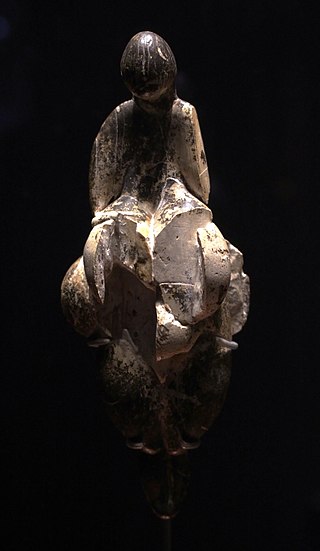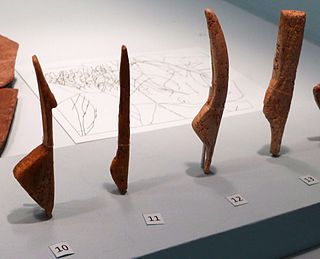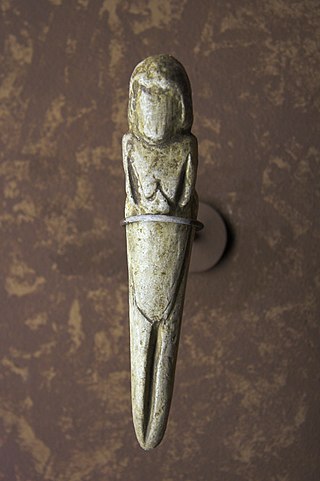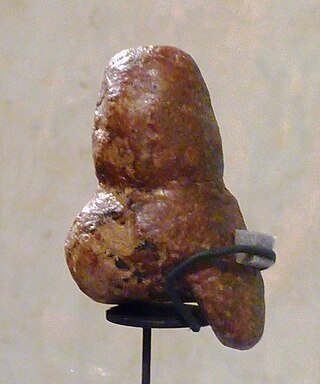
The Venus of Willendorf is an 11.1-centimetre-tall (4.4 in) Venus figurine estimated to have been made around 25,000–30,000 years ago. It was recovered on August 7, 1908 from an archaeological dig conducted by Josef Szombathy, Hugo Obermaier, and Josef Bayer at a Paleolithic site near Willendorf, a village in Lower Austria. The figurine was found by a workman named either Johann Veran or Josef Veram and is carved from an oolitic limestone that is not local to the area, and tinted with red ochre. It is now in the Natural History Museum in Vienna, Austria.

The Venus of Lespugue is a Venus figurine, a statuette of a nude female figure of the Gravettian, dated to between 26,000 and 24,000 years ago.

A Venus figurine is any Upper Palaeolithic statue portraying a woman, usually carved in the round. Most have been unearthed in Europe, but others have been found as far away as Siberia and distributed across much of Eurasia.

The Gravettian was an archaeological industry of the European Upper Paleolithic that succeeded the Aurignacian circa 33,000 years BP. It is archaeologically the last European culture many consider unified, and had mostly disappeared by c. 22,000 BP, close to the Last Glacial Maximum, although some elements lasted until c. 17,000 BP. In Spain and France, it was succeeded by the Solutrean, and developed into or continued as the Epigravettian in Italy, the Balkans, Ukraine and Russia.

The Venus of Brassempouy is a fragmentary ivory figurine from the Upper Palaeolithic, apparently broken from a larger figure at some time unknown. It was discovered in a cave at Brassempouy, France in 1894. About 25,000 years old, it is one of the earliest known realistic representations of a human face.

Paleolithic religions are a set of spiritual beliefs and practices that are theorized to have appeared during the Paleolithic time period. Paleoanthropologists Andre Leroi-Gourhan and Annette Michelson believe unmistakably religious behavior emerged by the Upper Paleolithic, before 30,000 years ago at the latest, but behavioral patterns such as burial rites that one might characterize as religious — or as ancestral to religious behavior — reach back into the Middle Paleolithic, as early as 300,000 years ago, coinciding with the first appearance of Homo neanderthalensis and possibly Homo naledi.

The art of the Upper Paleolithic represents the oldest form of prehistoric art. Figurative art is present in Europe and Southeast Asia, beginning between about 40,000 to 35,000 years ago. Non-figurative cave paintings, consisting of hand stencils and simple geometric shapes, are somewhat older, at least 40,000 years old, and possibly as old as 64,000 years. This latter estimate is due to a controversial 2018 study based on uranium-thorium dating, which would imply Neanderthal authorship and qualify as art of the Middle Paleolithic.

Grimaldi man is the name formerly given to two human skeletons of the Upper Paleolithic discovered in Italy in 1901. The remains are now recognized as representing two individuals, and are dated to ca. 26,000 to 22,000 years ago and classified as part of the wider Early European modern humans population of the late Aurignacian to early Gravettian.

Laugerie-Basse is an important Upper Paleolithic archaeological site within the territory of the French commune Les Eyzies-de-Tayac-Sireuil in Dordogne. It is known for several works of art from the Magdalenian. In 1979, Laugerie-Basse, along with other nearby paleolithic sites, was inscribed on the UNESCO World Heritage List as Prehistoric Sites and Decorated Caves of the Vézère Valley.

The Venus figurines from Gönnersdorf, at Neuwied, are paleolithic sculptures depicting the female body.

The Venus figurines of Mal’ta are several palaeolithic female figurines of the Mal'ta–Buret' culture, found in Siberia, Russia.

L'Abri Pataud, or the Pataud Shelter in English, is a prehistoric site found in the middle of the village Les Eyzies-de-Tayac-Sireuil in Dordogne, Aquitaine, southwestern France. The site includes human remains, stone tools, and early cultural artifacts made during the Upper Paleolithic, between approximately 47,000 and 17,000 years ago.
The Venus of Savignano is a Venus figurine made from soft greenstone (serpentine) dating back to the Upper Paleolithic, which was discovered in 1925 near Savignano sul Panaro in the Province of Modena, Italy.

The Venus of Mauern is a Venus figurine from the paleolithic era. The statuette stems from the Gravettian and is about 27.000 years of age. The figurine consists of red painted limestone and was found in 1948 in Mauern (Rennertshofen). It is housed in the Archäologische Staatssammlung in Munich.

The Venus figurines of Petersfels are several small female statuettes from the Upper Paleolithic era, carved from jet lignite. The tallest figurine is called the Venus of Engen. The figurines were discovered in the Petersfels caves near Engen, Baden-Württemberg, excavated in 1927–1932 by Eduard Peters und Volker Toepfer and then in 1974–1976 and 1978 by Gerd Albrecht. They stand between 1.5 and 4 cm tall and are about 15,000 to 11,500 years old, created during the Magdalenian era. They are housed in the Museums of Freiburg im Breisgau and Engen.

The Venus figurines of Gagarino are eight Palaeolithic Venus figurines made from ivory. The statuettes belong to the Gravettian industry and are about 21,000–20,000 years old. They were discovered near to the village of Gagarino in Lipetsk Oblast, Russia, and are now held in the Hermitage Museum in Saint Petersburg.

The Szeleta Culture is a transitional archaeological culture between the Middle Paleolithic and the Upper Palaeolithic, found in Austria, Moravia, northern Hungary, and southern Poland. It is dated to 44,000 to 40,000 years ago, a period when both Neanderthals and modern humans were present in Europe. Most experts think that it is a Neanderthal culture, but the issue is debated. It is named after Szeleta Cave in the Bükk Mountains in Hungary.

The Monpazier Venus, also known as the "Vénus de Monpazier," is a small, prehistoric figurine of a female form that was discovered in Monpazier, a medieval town in the Dordogne region of southwestern France. It was found accidentally in 1970 outside of its archaeological context. However, it has been dated by comparison with other female figures found in Europe. This figurine is an example of Paleolithic art, specifically from the Gravettian period, which is estimated to have occurred around 22,000 to 28,000 years ago.



















